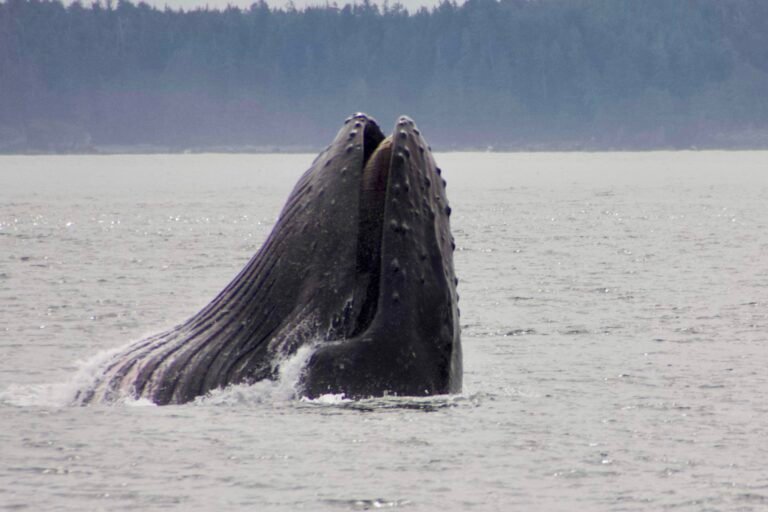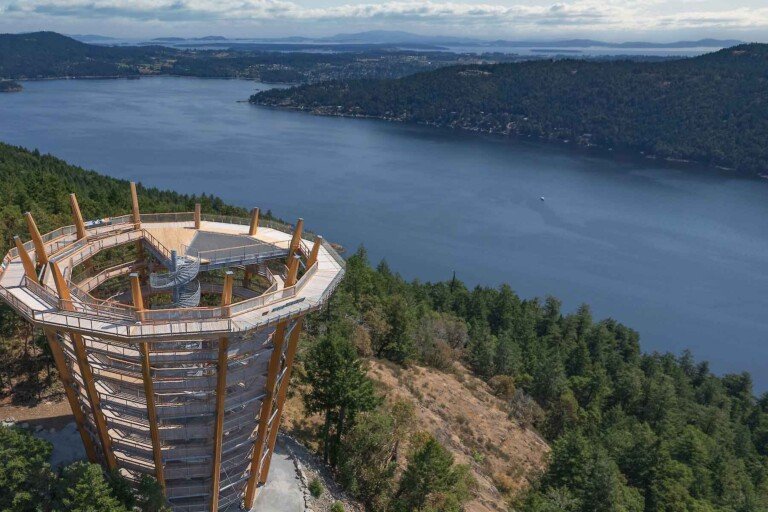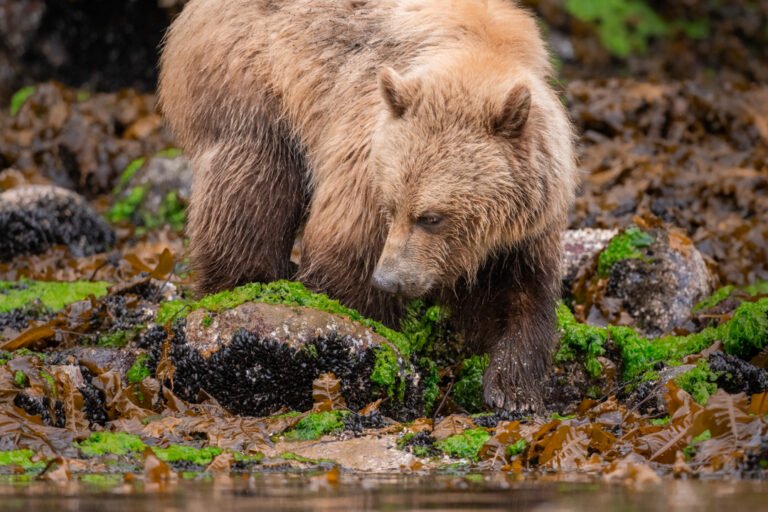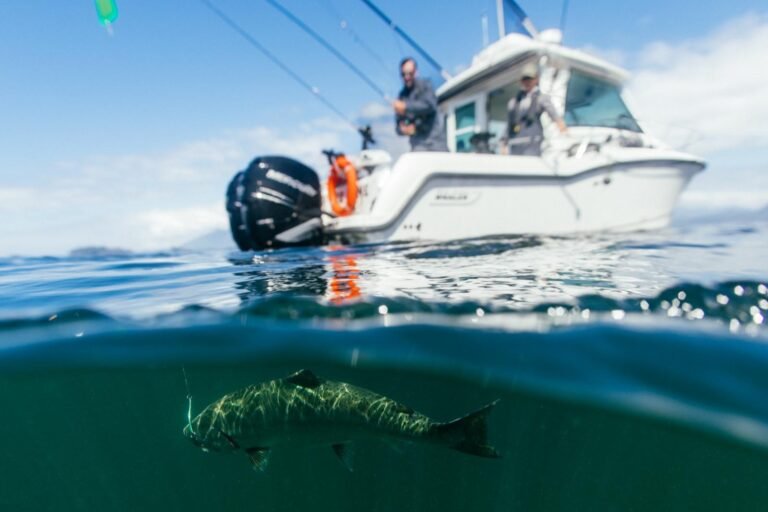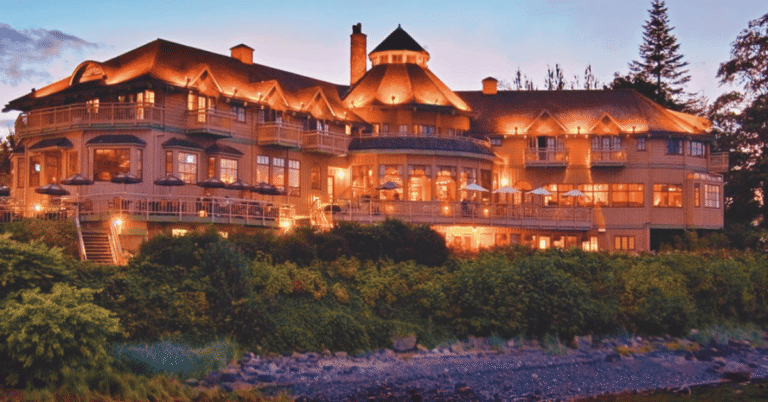Premier Listings: Cycling & Biking: Greater Vancouver
The character of a city is often defined by the vision of exceptional individuals. One of the first park commissioners of Vancouver, Matthew Logan, championed the idea of a pedestrian seawall that would eventually ring the entire harbour, from Stanley Park to False Creek. It took 55 years to complete, and today there is an almost seamless route that covers much of the distance (about 12 miles/20 km), certainly more than most of us can traverse in the course of a morning or afternoon’s outing.
Each year the Stanley Park Seawall and the Seaside Bikeway are thronged with an ever-larger number of walkers, joggers, in-line skaters, and cyclists. Experiments in blending the various groups have yielded the present system, which with its restrictions is still less than satisfactory to all. Just take your time, exercise caution, and wear a smile and you’ll do fine. Some stretches are busier than others. Unless you’re an ardent people-watcher, see if you can adjust the time of your visit to avoid the crowds that predictably descend on the seawall on Sunday afternoons. Good starting points for exploring the seawall on wheels include Brockton Point in Stanley Park and First Avenue between Cambie and Main Streets for the seaside bikeway. Parking is plentiful at both locations. Bikes and blades can be rented from a number of shops that border the park.
One of the best places to begin exploring the paths in Pacific Spirit Regional Park is at the park headquarters at 4915 W 16th Avenue. You can pick up a free map here that will outline all the trail options available to walkers, cyclists, and even in-line skaters. You’ll have to bring your off-road in-line skates with you, as most of the park trails are unpaved, although many are compact enough for skinny-tire cyclists to enjoy. A paved pathway does parallel much of 16th Avenue as it passes through the park.
For a cycle tour of Vancouver’s docks, begin from the corner of Powell and Commissioner Streets in east Vancouver where the Princeton Hotel, established in the early 1900s, is one of the most prominent heritage establishments. Cycle north from the Princeton on Commissioner Street, across the Canada Pacific Railroad (CPR) tracks. Past the container terminal – where cedar trees once stood so thickly, they concealed all view of the ocean. Commissioner is a largely untravelled waterfront street, with wide shoulders for cyclists to enjoy a long, lazy, rubber-necking, thirst-building ride. A boulevard of grass between the street and the rail line softens the environment on one side; a string of industrial and marine-related companies line the harbour on Commissioner’s west side.
Follow it far enough – a 1.5-mile (3-km) ramble – and you reach New Brighton Park. You’ll find the entrance to it on Wall St. Go east of Commissioner on Yale Street, then Wall Street, to New Brighton Park, the site of Hastings Mill, the first European settlement in Vancouver. Your reward for reaching the park will be one of the best views of the Lions from anywhere in Burrard Inlet. In summer, the park’s open-air swimming pool is a big attraction for eastside families.
Rocky Point Park in Port Moody is a place that will appeal to those with wheels to spin. The distance from the Vancouver-Burnaby boundary to Port Moody is 9 miles (15 km), an easy 30-minute jaunt by car at off-peak times. Drive along St. John’s Street, Port Moody’s main drag. Watch for signs that point to Rocky Point Park. Turn north on Moody Street and follow it to an overpass that leads to the park. A scenic, paved pathway wraps itself around the east end of Burrard Inlet and runs for several miles to Old Orchard Park. Paralleling it is a pedestrian-only walkway through the park. Rocky Point Park also has a lengthy pier running out into the shallow waters of Burrard Inlet’s eastern end. There’s swimming here, both in the ocean and in a freshwater pool. A boardwalk section of the walking trail passes over a marshy area of Burrard Inlet around Rocky Point. In spring and fall this is an excellent location for bird-watching.
The PoCo Dike Trail ribbons the western shore of the Pitt River. Similar to dike trails throughout the Fraser Estuary, the PoCo trail provides a broad, level surface on which to cycle, with plenty of room for all. The difference between the estuary and the Fraser Valley is that the mountains are much closer to the towns of Port Coquitlam (also called PoCo) and its neighbour, Coquitlam. Here at the northwestern end of the Fraser Valley a feast of eye-catching peaks rises up on both sides of the little prairie that the dikes protect from seasonal floods. On the dike, the challenge is horizontal, not vertical. On the PoCo Trail you can easily log 30 miles (50 km) round trip; double that if you tie your ride in with the Alouette River dike trails. (The Alouette is a tributary on the east side of the Pitt River and has a series of dike trails of its own that leads east from Pitt Meadows towards Maple Ridge. Cross the Pitt River Bridge to reach them from the PoCo Trail.)
Travel through Port Coquitlam on Hwy 7. Turn north on Dominion Avenue or Coast Meridian Road, just west of the Pitt River Bridge. (If you turn at Coast Meridian, turn east onto Prairie Drive.) Go east on either Dominion or Prairie until it reaches the dike, and park on the shoulder where permitted. There’s not much to see from the road, but as soon as you climb up to the trail you get a panoramic view. Once you get your wheels rolling, lift up your eyes and enjoy the scenery. Motion in the Pitt River sets the pace: log booms line sections of shoreline, while in places such as De Boville Slough, open areas attract anglers. The PoCo trail heads inland for a short distance in order to skirt the slough. North of here the trail becomes rougher as it enters Coquitlam. The slopes of Mount Burke are suddenly much closer at hand. The trail reaches its northern terminus at the foot of Minnekhada Knoll. A wooden picnic gazebo welcomes visitors and provides them with a view of Addington Point and the Pitt-Addington Marsh Wildlife Management Area. A rough trail not well suited for cycling curves out through this wildlife reserve and passes two observation towers positioned beside the river. There’s another viewpoint from the summit of Minnekhada Knoll. A trail leads to it from behind the kiosk, a steady 1-mile (1.6-km) hike.
Throughout the 1990s, the municipality of Langley has been one of the leaders when it comes to developing trails for cycling and in-line skating: the Langley Bike and Rollerblade Trails. This means that in many places you’ll find generous, paved shoulders on both the backroads and some of the principal routes that lead through this largely rural environment. Several routes lead from Fort Langley and Aldergrove Lake Regional Park.
The valley land between the Fraser River and the Canada-US border ripples away like the wake behind a troller. Early settlers didn’t have an easy go of it; the land was boggy and thick with mosquitoes in summer. But having come this far, they dug in, cleared the trees, farmed the land, and, in season, hunted and fished for wild game. You can still get a scent of those years as you pedal the backroads along the border of Surrey and Langley. Make Campbell Valley Regional Park, off 200th Street in Langley, your hub. Take Hwy 1 to the 200th Street exit and drive 9 miles (14.5 km) south to either the 16th or Eighth Avenue entrances. Or, from Hwy 99, take the Eighth Avenue East exit and travel 4.7 miles (7.5 km) to the South Valley entrance. (Note: Bicycles are not allowed on park trails.)
Begin your ride from either of the Campbell Valley Regional Park entrances on 16th or Eighth Avenue, head to 200th Street, then south to Zero Avenue, which runs along the Canada-US border. (Surprisingly, there aren’t any fences or signs forbidding crossings, just a dense scrub forest and one lone concrete marker.) Cycle west on Zero Avenue to 184th Street and then turn north. You are now on the Halls Prairie Road. Immediately watch for one of the most gracious (and spacious) pioneer farm homes on the east side as the road drops down into the Hazelmere Valley. Perched on the hillside, the view from here of the North Shore is captivating, particularly when the clouds part. From here, head to Eighth Avenue and then east to return to Campbell Valley Regional Park, for a total distance of 9 miles (14 km) round trip.
Other cycling trails of interest include the 7-11 Trail (easy; 25 miles/40 km return) that follows the SkyTrain route between New Westminster and Vancouver’s Clark Drive. Vancouver’s Riverfront Park has a lengthy, paved cycle and in-line skate pathway beside the mighty Fraser River. Throughout Vancouver, cyclists enjoy 30 designated bicycle commuter routes on streets such as Adanac, 37th Avenue, and Point Grey Road (all east-west), and Ontario, Heather, and Cypress (all north-south). Cyclists and in-line skaters also benefit from designated sections of sidewalk when crossing the Burrard and Cambie Bridges.
Early European and Asian settlers in the Fraser River Estuary quickly learned the importance of dike building to hold back both the ocean’s high tides and the river’s annual floodwaters. Lulu Island, the largest in the delta and home to the city of Richmond, is embraced by all three arms of the Fraser. Seven bridges and the George Massey Tunnel connect it to the rest of the Lower Mainland. One of the first dike trails constructed in the Fraser Estuary was on Lulu’s south shore at London’s Landing. Today, the island is ringed by 48 miles (77 km) of dikes topped by easygoing walking and cycling trails. As these trails are all level, you can cover a lot of ground in an outing while soaking up the island scenery.
Begin your jaunt at any one of numerous places along the dike. Two of the more popular starting points are Terra Nova, at the northwestern corner of the island, and Garry Point Park, on the southwestern tip. The Terra Nova trailhead is located at the west end of River Road. To get there, head west of Hwy 99 on Sea Island Way. Turn south onto No. 3 Road and drive to the next major intersection, Cambie Road. Turn west onto Cambie, which immediately blends into River Road. Follow River Road west to its end, beside the Terra Nova lands, and park there. An observation platform and picnic tables are located nearby. At this point you can choose to head in several directions. If you want to explore the open marsh, take the 3-mile (5-km) West Dyke Trail. If you are more inclined to watch the action on the Fraser River, try the Middle Arm Trail, which runs an equal distance east along Moray Channel. All trails are well signed with distances indicated in kilometres.
The West Dyke Trail connects Terra Nova with Garry Point Park. A cycle trip can just as easily begin from one point or the other. Garry Point Park lies 3 miles (5 km) south of Terra Nova in the fishing community of Steveston. The park entrance and trail are located at the west end of Chatham Street. Take the Steveston Highway West exit from Hwy 99 to reach Steveston.
The South Arm Dyke Trail begins at the foot of No. 2 Road, just east of the Steveston harbour, and runs 3 miles (5 km) to Woodward’s Landing Park beside the George Massey Tunnel and Hwy 99. Along the way, you’ll pass numerous interpretive signs that outline interesting aspects of natural history, such as bird and fish migrations, as well as heritage sites. This section of trail offers a variety of stops for visitors to explore. You can pause for a look around at London Farms, picnic on the pier at the foot of No. 2 Road, and check out the old river homes on Finn Slough at the foot of No. 4 Road.
Sea Island‘s backroads are a good place to cycle while watching planes or eagles, osprey, and heron, take off and land. A good place to begin is Iona Beach Regional Park. A causeway links Iona Island with Sea Island. Plan on taking 45 minutes or so to pedal the lengthy 7.5-mile (12-km) stretch of paved backroads that lead across Sea Island along Grauer, Mchttps://britishcolumbia.com/wp-content/uploads/2020/07/discovery-islands-lodge-1-accommodation-quadra-island-british-columbia-1.jpg, and Ferguson Roads. If the backroads don’t completely satisfy your will to wheel, tack on another 5.5 miles (9 km) by riding out to the end of Iona’s jetty and back. By then you’ll be saddle weary, for sure!
An impressive stretch of dike trail runs beside Mud and Boundary Bays in Delta, Richmond’s neighbour to the south. The Boundary Bay Regional Trail, which includes the East Delta Dike Trail, winds around both bays, skirting the mudflats that once extended much farther inland. Today’s dike is a much sturdier version than the crude ones built at the turn of the century. You can put in a full day cycling 12 miles (20 km) one way between the Surrey-Delta border and Boundary Bay Regional Park in Tsawwassen. There are always shorebirds to entertain you, and towards evening the sky around Mount Baker lights up in the southeast. Access points to the dike trail include the entrance to Boundary Bay Regional Park at the east end of 12th Avenue in Tsawwassen, the south end of 64th or 72nd Street off Dewdney Trunk Road, and the south end of 96th, 104th, or 112th Street off Hornby Drive near Dewdney Trunk Road’s intersection with Hwy 10.
Point Roberts is located on the extreme southern tip of the peninsula that defines Boundary Bay’s western shoreline. Cyclists must cross the Canada-US border on Point Roberts Road in Tsawwassen to enter or leave the tiny enclave. Except for a steep hill south of Maple Beach, exploring Point Roberts makes for a mostly level, 2-hour tour by bike. The roads blend into one another in a simple rectangular grid and are easy to follow. Whatcom County, Washington, of which Point Roberts is a part, maintains Lighthouse Park, a delightful and often overlooked park at the extreme southwestern point of the mainland. From this windswept point, cyclists are rewarded with some of the best views on the entire Fraser Estuary: Haro Strait and the Strait of Juan de Fuca as well as the Strait of Georgia open up on three sides.
There’s even more cycling to be had along the dike at Brunswick Point, about 3 miles (5 km) west of Ladner in Delta. To find the entrance to the dike, head west on Ladner Trunk Road from downtown Ladner. Ladner Trunk Road soon becomes River Road West. About 2 miles (3 km) west of Ladner, River Road West passes the bridge over Canoe Passage, which links Delta with Westham and Reifel Islands. The road continues past the bridge for another 1.5 miles (2.5 km) as it winds its way to a gated cul-de-sac. There is parking here, beside the dike. Mount up and pedal off.
A branch of the South Arm of the Fraser River spreads out beside the dike. It seems so relieved to have finally accomplished its long run to the ocean that it emits a contented gurgle. As the river narrows between Westham Island and Delta, it forms Canoe Passage. From the parking area, the dike trail leads west and then south as it curves around Brunswick Point. Canneries once thrived here at the turn of the last century, as attested to by the orderly rows of creosoted pilings that march like a doomed army out towards Roberts Bank. Suddenly, the city seems very remote. In the distance, a wall of Coast Mountains runs down the Sunshine Coast, crosses the North Shore, and then heads towards the Golden Ears, the distinctively shaped twin peaks of Mount Blanshard in the north Fraser Valley. The Strait of Georgia expands west to Vancouver Island. This scene is painted with broad brush strokes indeed. One of the joys of such an easygoing trail is that you can ride with your head up. You can do as much rubbernecking as you please without worrying about a mishap.
It will take you 30 minutes to ride the 4.5 miles (7 km) from the Brunswick Point trailhead to the beginning of the Roberts Banks coal port causeway, which juts out onto the bank. Freighters load coal brought here in railcars from southeastern British Columbia. You can ride out on the lengthy causeway for a look back at Brunswick Point and add another 4.5 miles (7 km) to your journey. The Tsawwassen Indian Reserve begins just south of the causeway. If the gate is open, you can extend your ride to the BC Ferries Tsawwassen terminal causeway, about 2 miles (6 km) farther south, in Tsawwassen. By now you will be several hours from where you began. Along the way you will pass viewpoints and places where you can park your bike and rest atop a driftwood log. There’s always plenty of wildlife along the shoreline, where herons stand on guard while rafts of waterfowl drift offshore.
Barnston Island in Surrey has the flavour of both the Fraser Estuary and the Fraser Valley rolled into one. A protective dike rings the diminutive island, which has a distinctly agricultural air (and aroma). Dairy farming is the main focus these days, as the soil is infested with iron worms, a nasty little predator that attacks root crops. A park was created at Robert Point on the northwestern tip of the island. A small barge operates between the Surrey mainland and Barnston Island, which lies east of Surrey Bend, and just beyond sight of the Port Mann Bridge. There is no charge to use the ferry, which takes less than 5 minutes to cross Parsons Channel. To reach the ferry dock, take the 104th Avenue exit off Hwy 1 and follow it east until it ends. Take 176th Street if you’re approaching from the east. It meets 104th at the ferry dock. The free ferry runs on demand from 6:20am every day until midnight.
Although much of Barnston Island is private property, there are access points to the river, particularly at Robert and Mann Points. From the north side of the island, the view is out over the Fraser River across log booms and open water to the far shore, where light planes buzz around the Pitt Meadows Airport. In the distance some familiar landmarks loom, such as the knolls in the Pitt River Valley and the Golden Ears to the northeast. For most of the time you spend cycling on Barnston, your attention will probably turn away from the river and towards the mighty contented cows, pigs, spring lambs, and ponies in nearby fields.
The best view of the island is from the ferry landing as you arrive. Look east past the farmhouses across the fields. In the distance is Mann Point, the site of an old orchard where you can sit with your legs hanging over the high bank and watch families of Canada geese. In springtime, goslings are strung out in a row behind their parents on the water, with their legs pumping against the current to keep up. There are no tricks to this 6-mile (10-km) loop road that rings the island. The choice of directions is simply left or right from the ferry dock. If you head right and wish to reach the slippery shoreline south of Mann Point, watch for a trail that leads down the embankment just before an especially well-kept farm. Walk from here to the point for a look at the eagles, herons, and geese that enjoy the protection of the Barnston shoreline. Facing the island on the Surrey side is a typical Fraser River industrial scene, presently the island itself has no commercial development. In addition to the loop road around Barnston, a secondary road leads through the farm fields at mid-island.


